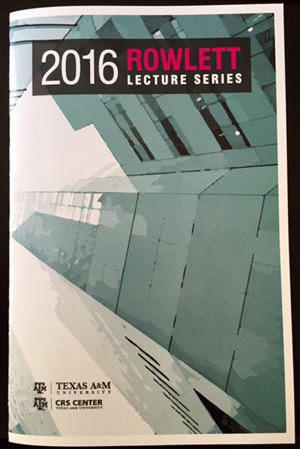 Last week I attended the last day of the 2016 Rowlett Lecture Series at the Bush Library at Texas A&M in College Station. It was a two-day affair that celebrated the 25th anniversary of the CRS Center. CRS (Caudill Rowlett Scott) was a legendary global architecture firm that started at College Station in the 1940s. Its principals taught hundreds, if not thousands, of architects and engineers Architecture By Team and Problem Seeking, processes that are still used by firms across the globe today. The CRS Center houses the historical documents and books that were produced by the firm.
Last week I attended the last day of the 2016 Rowlett Lecture Series at the Bush Library at Texas A&M in College Station. It was a two-day affair that celebrated the 25th anniversary of the CRS Center. CRS (Caudill Rowlett Scott) was a legendary global architecture firm that started at College Station in the 1940s. Its principals taught hundreds, if not thousands, of architects and engineers Architecture By Team and Problem Seeking, processes that are still used by firms across the globe today. The CRS Center houses the historical documents and books that were produced by the firm.
The firm and the multitude of professionals who worked on the CRS team were "Disrupters" of the profession, and it is no wonder that those CRS processes have morphed and are being used by architectural firms in the development of complex buildings and campuses today.
I was fortunate to have played on the CRS team first as a programmer and later as the Director of Marketing. I went to hear the latest iteration of the application of the CRS Problem Seeking methodology on projects and to see many of my former colleagues and friends.
One of the feature presentations was by Scott Simpson, FAIA and Senior Principal at the Greenway Group and Editor at Large of Design Intelligence. His talk, about the length of a TED talk, touched on the future of the architectural profession and he flashed a slide of the "Disrupters" of the design profession, those that will have a profound impact on the architects and the designs of the future.
His list of "Disrupters" included: big data, algorithmic design, gaming, 3D printing, drones, robotics, sophisticated pre-fab, zero-carbon, 100% recycling of buildings and “self driving buildings.” Scott urged the audience, ranging in age from freshmen in the A&M architectural program to post retired architects, to pay attention to the rapidity of change and to the future that will be both different and more demanding of the design and construction professions over the next 25 years.
While the Simpson presentation was aimed at the design professionals, the implications on the construction industry will force major change to an industry still accustomed to building “two inches at a time.”


